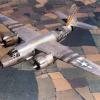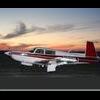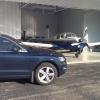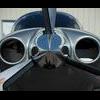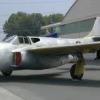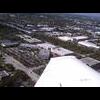Leaderboard
Popular Content
Showing content with the highest reputation on 04/16/2013 in all areas
-
Just a quick update, I've been working with Will James of James Aircraft to create the new nose. I have the inlet rings for the cooling air and carb air and am working on the mould for the aluminum. Slow but steady. David4 points
-
Hi guys, I convinced Erika, my wife, to tape my take off and landing...2 points
-
I'd like to introduce myself as a proud new owner of a 1963 Mooney M20C that I recently purchased from a great seller in TX. I flew to TX, did the pre-inspection of the plane and all log books, took a test flight and had the owner do three landings to allow me to get a feel for the plane, then I jumped in the driver seat and did two excellent landings, even greased the 2nd one! I owe all the reading I've done on this site to prepare me for the Johnson Bar, Manual flaps (love both of them over electric now) and approach pattern speeds. I rounded out on final at 80 mph and the Mooney just sat down on the runway nicely, no floating. After the paperwork was complete, I jumped in and headed straight for MS to visit family and again, great landings. Flights from MS to TN with a proud mother, from TN to MS with mother, sister and niece, then back to TN with sister and niece, then off to VA for its home airport. All landings were great except for VA when the ATIS was down. Luckily some g1000 Cessna's were in the pattern; unlucky, reported 18kt direct crosswinds. My first landing I had to immediately reject due I had come in full flaps. As I got back into the pattern, I remembered the reading material stating no flaps for high winds and on the 2nd attempt, I came in with no flaps, less power but did stall the airplane about 6' off the runway to make for a hard hit. The plane did not bounce, just kept on rolling. Lesson learned!!! As far as performance, the engine was recently top overhauled so still running mineral oil for the break in. Prop is brand new and the plane has the 201 windshield and flap gap seals. This plane cruised at 145kts no wind and hit 170kts for about 10 minutes between TN and VA over the mountains. This plane is fast!!! I'm happy to be a mooney owner and look forward to many cross country trips. Now I just have to get the vor/ils repaired, get my ipad mini (great vfr gps!) mounted on the yoke (ordered the parts), fix a couple of minor issues and get the plane IFR certified! John1 point
-
http://www.kickstarter.com/projects/525000827/reve-bleu-bugattis-blue-dream-will-finally-fly?ref=home_location This is a project I've been following since it got started and he's on the home stretch to flying this truly beautiful plane for the first time in history.. Robb1 point
-
I have a funny filter story, funny that is until I figured out how much it was costing me. On my PC system there were at least two, maybe three "vacuum" filters on the pneumatic system. They were changed out every annual. Back in the early 90s they were somewhere in the $20 each range. I was able to buy them myself and used them doing my owner assisted annuals. One annual I was taking them out of the box and I noticed the label was loose on one of them and like a Cirrus guy seeing terra firma from a bad angle, I pulled it - only to reveal a nice "Fram G2" underneath. Went down to the local auto parts store to find that wonderful gasoline filter on sale for $1.50. I'm sure there was $18.50 in "value" there, but I sure couldn't find it. My suspicion is that the label cost $18.50.1 point
-
1 point
-
1 point
-
Oscar -- these keep getting better and better. After you become a famous movie director, I am going to be saying "I knew Oscar when he was just a Mooney pilot" Nice work.1 point
-
I read somewhere that the primary advantage of synths is the ability to not break down under extended service, which is not a factor in our engines because we change oil frequently. Might as well just use a good regular oil of the correct weight for the aircraft and season. So that is why I use Phillips.1 point
-
I love the way FlyWalt tried to end this thread. I think he figured out he just stuck a stick in the proverbial oil beehive and the CamGuard bees will soon be on the loose. Oil in GA is a never ending topic. Other than Blackstone's comment on the matter, I would love to see a truly comprehensive analysis of the data supporting type/brand of oil and it's impact on TBO.1 point
-
That's the wrong accident from the video. As far as I'm concerned, if you lose a propellor, control surface or something major, you are now in the same position as a test pilot of an aircraft dropped into the air in close proximity to the ground. This is the accident caught on tape: http://www.ntsb.gov/aviationquery/brief.aspx?ev_id=20090301X04523&key=1 This accident involved a field overhauled engine that gave issue on the takeoff roll on a 2600ft runway. The pilot only had around 850 TT and 50 in type (not being critical, I only have around 400-500 with 200 in the Mooney). It sounds like they were committed to the takeoff and had to follow through with it. The sad thing is he stall-spun into a field. Remember, the moment you have an engine failure, it is no longer your airplane. It belongs to the insurance company.1 point
-
1 point
-
1 point
-
1 point
-
1 point
-
I have adjusted ours three times. Its 25 RPM per full turn on that stop screw on the McCauley governor. First make sure that the prop is digitally verified to be low on RPM. Then make sure the arm is hitting the stop screw. You first adjust the stop screw, then, adjust the rod end on the prop cable so the arm hits the stop screw full forward on the prop control. Make sure that the knob or lever has ever so slightly more travel than required to make the governor arm hit the stop. 1/2 turn on the rod end beyond what is required to make it hit the stop on the governor is about right. The cable shouldn't limit the travel on the RPM, the stop screw should. Go fly it 5 minutes with the prop control full forward and at least 75% power. Verify that you are getting 2700 RPM. If it is not 2700 (I would use +15 RPM, -25 RPM), readjust then re-test. Note, the A3B6D configuration is easy to adjust. The A3B6 is a real #$%@**$^)%1 point
-
LOL......all marketing hype ......TBO is just recommended.....you and your mechanic are responsible for making the determination if the engine is in good working order......the industry should be more honest and advise on real world experience like a TSIO 360LB needing a top at mid-time and a TSIO550 sheldom making more than 750 if flow in the FLs. I am always amazed how naive new Pilots assume a mid-time engine with good compressions should last another 800 hrs etc (me when I bought my 231 in 1992). TBO = Totally Bogus Objective!1 point
-
1 point
-
Flywalt, My original TSIO 360(GB) started collecting sludge after 1600 hrs. I changed my oil change frequency to every 35 hrs and the situation improved considerably. The engine was rebuilt by Continental at 1725 hrs (upgraded to LB) and I have stayed with the 35 hr oil change interval. Sludge build-up is more prevalent in high time engines (mostly due to blow-by and poor scavenging) so more frequent oil changes help manage the situation all else being equal (compressions better than 70/80 etc). Mineral oils are better at scavenging than synthetics but AeroShell 15w50 is a semi-synthetic so it does fine. Continental cams are less prone to corrosion than Lycoming (I also own a Malibu Mirage) due to the location given average usage. The best way to keep your engine healthy is to fly every week and change your oil every 35 hrs. Watch the temp and MP limits.....our engines need more TLC than newer versions but still remain very efficient. I get 170K TAS at 11 gph (11k FT) and compressions are 76/80 or better. Enjoy your plane, I still prefer my 231 for solo XC flights.1 point

